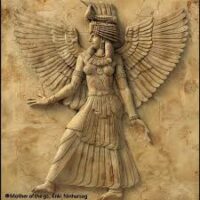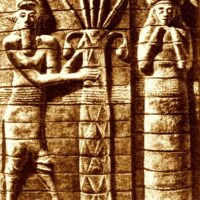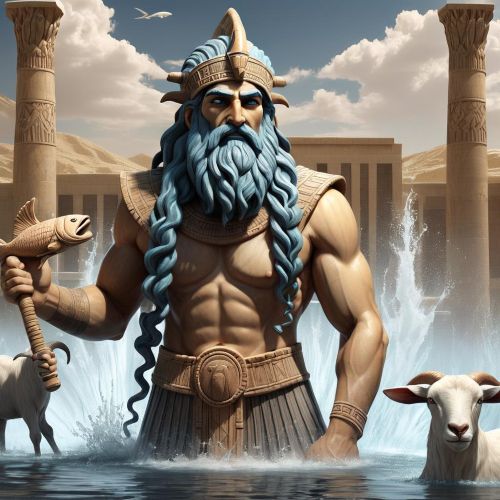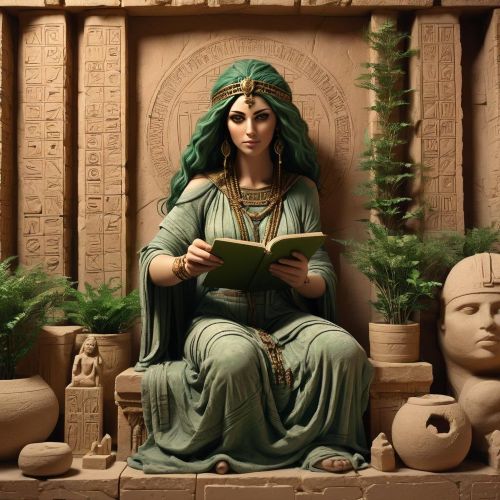Ninhursag : The Mother Goddess
Listen
At a glance
| Description | |
|---|---|
| Origin | Sumerian Mythology |
| Classification | Gods |
| Family Members | An (Father), Ki (Mother), Enki (Husband), Ninsar, Ninkurra, Uttu & Ninurta (Children) |
| Region | Iraq |
| Associated With | Fertility, Mountains, Creation |
Ninhursag
Introduction
Ninhursag, revered as the “Lady of the Sacred Mountain,” stands among the most ancient and significant deities in Sumerian mythology. She represents the earth’s fertile power, the nourishing force of nature, and the sacred role of the mother goddess. Her worship dates back to the early dynastic period of Sumer, and she features prominently in many Mesopotamian texts. As one of the four primary creator gods—alongside Anu, Enlil, and Enki—Ninhursag occupies a vital role in shaping human destiny and divine order. Stories like “Enki and Ninhursag” showcase her as a life-giving and healing figure, deeply embedded in the mythological imagination of the ancient Near East. Her essence permeates the soil, the womb, and the mountainous landscapes that were seen as the birthplace of gods and men.
Physical Traits
Ninhursag’s visual representation in Sumerian art is deeply symbolic. She is often shown enthroned upon a stylized mountain, reinforcing her dominion over the earth and all growing things. Her horned crown identifies her as divine, while her elaborate tiered robe mirrors the stepped structure of sacred hills and ziggurats. The most distinctive feature in some depictions is her hair, styled in the shape of the Greek omega (Ω), interpreted as a symbol of life, fertility, or the womb. Accompanying animals such as ibexes, deer, and lions further emphasize her connection to untamed nature. These elements together portray her not only as a mother figure but also as a powerful and majestic force of the natural world.
Family
The lineage and relationships of Ninhursag vary across different Sumerian sources, highlighting her expansive influence across mythic traditions. She is sometimes considered the daughter of An and Ki, the primordial sky and earth deities, though her origins are not always clearly outlined. In certain myths, she is paired with Sulpae, a lesser-known deity connected to the underworld and celestial bodies. However, her most dynamic partnership is with Enki, god of water, wisdom, and fertility. Their union results in the creation of several important deities, including Ninsar, Ninkurra, and Uttu. In the story of Enki and Ninhursag, her ability to bring forth new life manifests when she births eight healing deities from Enki’s afflicted organs. These divine children serve as personifications of restoration and harmony. Additionally, she is cited as the mother of Ninurta in some traditions, placing her within the divine lineage of war and agriculture.
Other names
Ninhursag has been known by numerous names throughout Mesopotamian history, each reflecting different aspects of her role and worship. As Ninmah, or “Great Queen,” she is honored for her authority and creative power. When referred to as Nintu or Nintud, she is invoked as the lady of birth and midwifery, emphasizing her function in the procreation of both divine and human life. The name Belet-Ili, meaning “Mistress of the Gods,” underscores her maternal oversight over the pantheon. In some texts, she is called Mamma or Mami, designations that evolved into later goddess figures with similar traits. The epithet Dingirmah, which denotes an exalted status, was one of the most widely used in later periods. These overlapping identities reveal the fluid and multifaceted nature of ancient Mesopotamian theology, where divine roles could merge or evolve with cultural shifts.
Powers and Abilities
Ninhursag’s powers extend across the realms of creation, healing, fertility, and divine authority. Her role in forming humans from clay, as seen in myths where she collaborates with Enki, places her at the heart of Sumerian cosmogony. She is not only a bringer of life but also a sustainer of it. Her healing prowess is prominently displayed when she cures Enki by creating deities from his ailing body parts, demonstrating her restorative influence over the cosmos. As a goddess of childbirth, she oversees conception and delivery, both in the physical and metaphorical sense, making her temples places of petition for fertility and safe labor. She is also linked to the health of the land, with her blessings believed to ensure bountiful harvests and the prosperity of cities. In royal ideology, Ninhursag is often portrayed as a legitimizing force, placing crowns on kings and nourishing them as a divine mother, which anchored the king’s authority in divine favor. Her essence permeates protective spells, agricultural rituals, and theological hymns alike.
Modern Day Influence
Though direct worship of Ninhursag faded with the decline of Sumerian city-states and the rise of newer religious systems, her mythological imprint remains evident in several ways. Scholars have drawn parallels between her and later maternal or earth goddesses in other cultures, including figures like Gaia, Demeter, and even biblical archetypes such as Eve. In particular, the myth of Ninti—one of the healing deities she births—is noted for its linguistic and thematic resemblance to the story of Eve being formed from Adam’s rib. This has spurred considerable academic interest in how Mesopotamian myths may have influenced later Abrahamic traditions.
In modern spirituality and goddess worship, Ninhursag is sometimes reclaimed as an archetype of divine femininity. Neo-pagan and reconstructionist groups view her as an emblem of balance, nurturing, and creation, fitting into broader movements that honor earth-based spirituality and ancient wisdom. Her symbolism—particularly the mountain, womb, and horned crown—appears in visual art, feminist literature, and ecological discussions that celebrate the interconnectedness of life and the sacredness of nature. While temples no longer rise in her name, Ninhursag’s legacy endures in cultural memory, scholarly discourse, and the collective imagination of those who seek to reconnect with the primal powers of the earth.
Related Images
Source
Asher-Greve, J. M., & Westenholz, J. G. (2013). Goddesses in Context: On Divine Powers, Roles, Relationships and Gender in Mesopotamian Texts. Fribourg: Academic Press.
Kramer, S. N. (1963). The Sumerians: Their History, Culture, and Character. University of Chicago Press.
Mark, J. J. (2017). Ninhursag. World History Encyclopedia. https://www.worldhistory.org/Ninhursag/
Ninhursag. (2025). World History Edu. https://worldhistoryedu.com/ninhursag-the-ancient-sumerian-mother-goddess-of-the-mountains/
Wikipedia contributors. (2025). Ninhursag. Wikipedia. https://en.wikipedia.org/wiki/Ninhursag
Frequently Asked Questions
What is lorem Ipsum?
I am text block. Click edit button to change this text. Lorem ipsum dolor sit amet, consectetur adipiscing elit. Ut elit tellus, luctus nec ullamcorper mattis, pulvinar dapibus leo.
What is lorem Ipsum?
I am text block. Click edit button to change this text. Lorem ipsum dolor sit amet, consectetur adipiscing elit. Ut elit tellus, luctus nec ullamcorper mattis, pulvinar dapibus leo.
What is lorem Ipsum?
I am text block. Click edit button to change this text. Lorem ipsum dolor sit amet, consectetur adipiscing elit. Ut elit tellus, luctus nec ullamcorper mattis, pulvinar dapibus leo.
What is lorem Ipsum?
I am text block. Click edit button to change this text. Lorem ipsum dolor sit amet, consectetur adipiscing elit. Ut elit tellus, luctus nec ullamcorper mattis, pulvinar dapibus leo.
What is lorem Ipsum?
I am text block. Click edit button to change this text. Lorem ipsum dolor sit amet, consectetur adipiscing elit. Ut elit tellus, luctus nec ullamcorper mattis, pulvinar dapibus leo.















